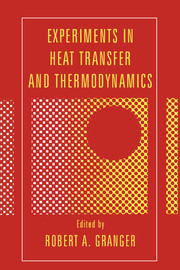Book contents
- Frontmatter
- Contents
- Preface
- Introduction
- Part I Experiments in heat transfer
- I.1 Conduction
- Experiment 1 Critical radius of insulation
- Experiment 2 The regelation of ice – the effect of heat conduction
- Experiment 3 Unsteady heat conduction in a sphere
- Experiment 4 Heat conduction in materials with nonhomogeneous structure
- Experiment 5 Measurement of thermal conductivity of solids during chemical reactions
- Experiment 6 Temperature measurements in a transparent material: Application of the holographic interferometry
- I.2 Convection
- I.3 Boiling
- I.4 Mixing, dispersion, and diffusion
- I.5 Radiation
- I.6 Heat pipes and exchangers
- Part II Experiments in thermodynamics
- Appendix 1 Experiments and demonstrations in thermodynamics
- Appendix 2 Experiments and demonstrations in heat transfer
- Appendix 3 Heat-transfer and thermodynamic films
- Index
Experiment 4 - Heat conduction in materials with nonhomogeneous structure
Published online by Cambridge University Press: 05 June 2012
- Frontmatter
- Contents
- Preface
- Introduction
- Part I Experiments in heat transfer
- I.1 Conduction
- Experiment 1 Critical radius of insulation
- Experiment 2 The regelation of ice – the effect of heat conduction
- Experiment 3 Unsteady heat conduction in a sphere
- Experiment 4 Heat conduction in materials with nonhomogeneous structure
- Experiment 5 Measurement of thermal conductivity of solids during chemical reactions
- Experiment 6 Temperature measurements in a transparent material: Application of the holographic interferometry
- I.2 Convection
- I.3 Boiling
- I.4 Mixing, dispersion, and diffusion
- I.5 Radiation
- I.6 Heat pipes and exchangers
- Part II Experiments in thermodynamics
- Appendix 1 Experiments and demonstrations in thermodynamics
- Appendix 2 Experiments and demonstrations in heat transfer
- Appendix 3 Heat-transfer and thermodynamic films
- Index
Summary
Principle
A linear heat source placed in a material of semi-infinite nature causes temperature changes due to heat conduction. The relationship between temperature at a given distance from the heat source and time in the coordinate system (T - To, log t) is linear after some time.
Object
The experiment demonstrates heat conduction in semi-infinite space. It allows one also to obtain experimentally both the thermal conductivity and the thermal diffusivity of the material. An object used for the experiment can be any material in the form of powder, granules, or paste in bulk.
Apparatus
The apparatus consists of a glass beaker (diameter 0.1 m, height 0.2 m) which is filled with a selected material. At the center of the beaker a linear heat source 0.1 m long is placed and there is a temperature sensor parallel to the heater at a distance of 10 mm from the heater (Fig. 4.1). Both of them are in the form of a capillary metal tube 0.2–0.5 mm in diameter. The heat source is connected to a stabilized power supply (approximately 1.5 W) and the temperature sensor to a display and/or to a recorder.
Procedure
The experiment is carried out at ambient temperature. Switch on the power and register temperature in 2 minute intervals for 20 minutes. After completing the experiment remove the heat source and the temperature sensor to cool them to ambient temperature.
- Type
- Chapter
- Information
- Experiments in Heat Transfer and Thermodynamics , pp. 19 - 22Publisher: Cambridge University PressPrint publication year: 1994
- 1
- Cited by



